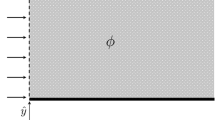Abstract
A simple algebraic model of turbulent boundary layer on convex curvilinear surfaces is suggested that is based on the generalization of the two-layer one-parameter algebraic model for a flat plate [ 1 ]. The model is tested in a wide range of variation of the curvature parameter (0.01 ≤ δ0/R w ≤ 0.09, where δ0 is the thickness of the boundary layer at the initial cross section of the curvilinear region andR w is the curvature radius of the surface), the results of which are indicative of a good agreement between the experimental and calculated data on the integral characteristics of the boundary layer, namely, the friction coefficientC f , the displacement thickness δ* and momentum thickness δ**, and the form parameterH = δ*/δ**. Based on the comparison between the calculated and experimental data on the distribution of tangential turbulent stresses, a conclusion is made that the model predicts a much lower effect of the curvature on the suppression of turbulence in the outer region of boundary layers at a mild curvature of the surface (δ 0 /R w = 0.01) than in experiments. However, this difference has a tendency to decrease as the surface curvature increases. An analysis of the calculated and experimental velocity profiles plotted in the variables of the wall law leads to a conclusion that the generalized Townsend wall law is partially realized on a curvilinear surface.
Similar content being viewed by others
References
Garbaruk, A.V., Lapin, Yu.V., and Strelets, M.Kh.,Teplofiz. Vys. Temp., 1999, vol. 37, no. 1, p. 87 (High Temp. (Engl. transi.), vol. 37, no. 1, p. 82).
Prandtl, L., Einfluss stabilisierender Kräfte auf die Turbulenz, inSonderdruck Vorträge aus dem Gebiete der Aerodynamik und verwandter Gebiete, Aachen, 1929.
So, R.M.C. and Mellor, G.L.,J. Fluid Mech., 1973, vol. 60, p. 43.
Gillis, J.C. and Johnston, J.P.,J. Fluid Mech, 1983, vol. 135, p. 123.
Gibson, M.M., Verriopoulos, C.A., and Vlachos, N.S., Turbulent Boundary Layer on a Mildly Curved Convex Surface,Exp. Fluids, 1984, vol. 2, p. 17.
Muck, K.C., Hoffmann, P.H., and Bradshaw, P.,J. Fluid Mech., 1985, vol. 161, p. 347.
Turbulentnost’ (Turbulence), Bradshaw, P., Ed., Moscow: Mashinostroenie, 1980 (Russ. transi.).
Ginevskii, A.S., Ioselevich, V.A., Kolesnikov, A.V.,et ai, Itogi Nauki Tekh., Ser.: Mekh. Zhidk. Gaza, 1978, vol. 11.
Khalatov, A.A.,Inzh. Fiz. Zh., 1996, vol. 69, no. 6, p. 927.
Ustimenko, B.P.,Protsessy turbulentnogo perenosa vo vrashchayushchikhsya techeniyakh (Processes of Turbulent Transport in Rotating Flows), Almaty: Nauka, 1977.
Bradshaw, P.,AGARDograph, 1973, no. 169.
Wilcox, D.C. and Chambers, T.L.,AIAA J., 1977, vol. 15, no. 4, p. 574.
Sovremennoe sostoyanie gidroaerodinamiki vyazkoi zhidkosti (Current Status of Research into Aerohydrodynamics of Viscous Liquid), Gol’dshtein, S., Ed., Moscow: Izd. Inostrannoi Literatury, 1948, vol. 1 (Russ. transi.).
Lapin, Yu.V. and Pospelov, V.A.,Teplofiz. Vys. Temp., 1995, vol. 33, no. 3, p. 422 (High Temp. (Engl. transi.), vol. 33, no. 3, p. 421).
Loitsyanskii, L.G.,Izv. Nauchno-Issled. Inst. Gidrotekh., 1933, vol. 19.
Townsend, A.A.,J. Fluid Mech., 1961, vol. 11, p. 97.
Huang, P.G. and Bradshaw, P.,AIAA J., 1995, vol. 33, no. 4, p. 624.
Spalart, PR. and Allmaras, S.R., A One-Equation Turbulence Model for Aerodynamic Flows,AIAA Pap., 1992, no. 92-0439.
Spalart, PR. and Shur, M.L.,Aerosp. Sci., Technol., 1997, vol.1, no. 5, p. 297.
Author information
Authors and Affiliations
Rights and permissions
About this article
Cite this article
Labusov, A.N., Lapin, Y.V. Algebraic model of turbulent boundary layer on a convex curvilinear surface. High Temp 38, 434–443 (2000). https://doi.org/10.1007/BF02756004
Received:
Published:
Issue Date:
DOI: https://doi.org/10.1007/BF02756004




